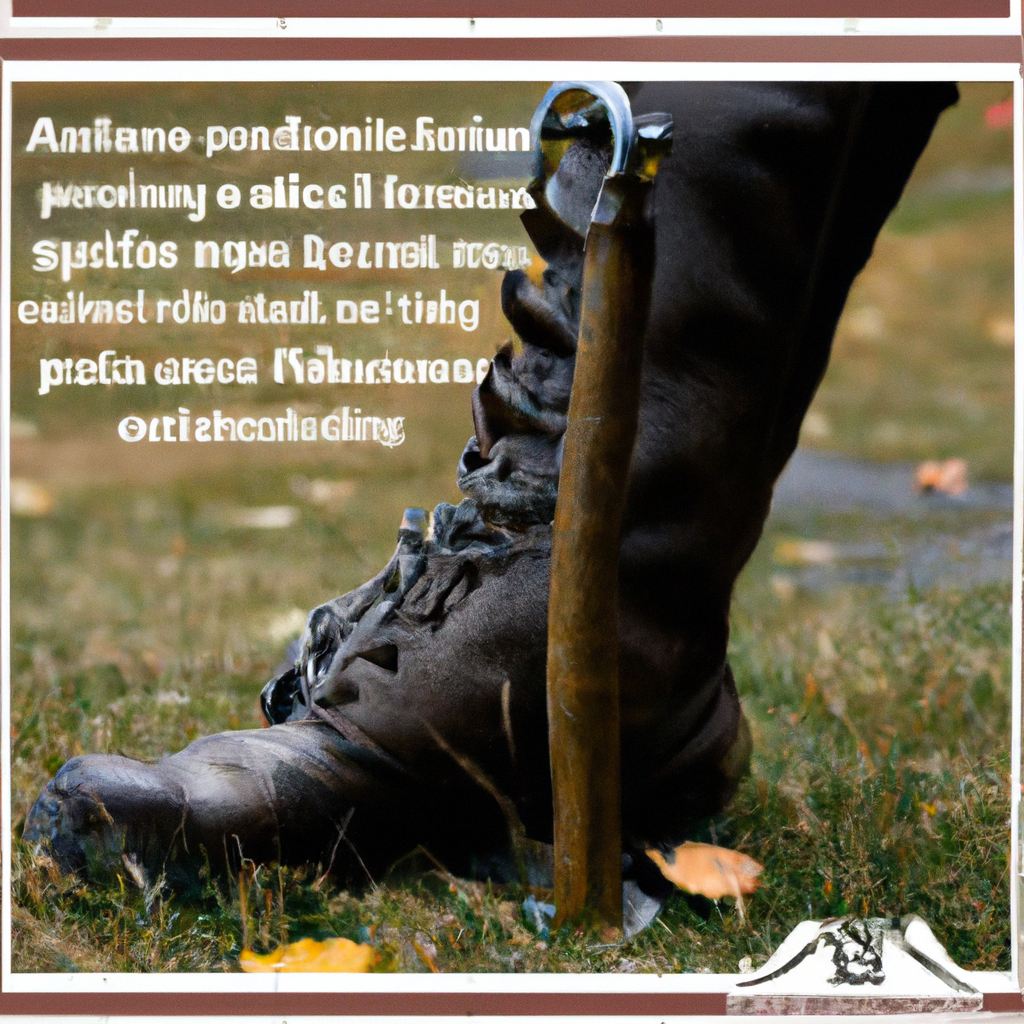Have you ever wondered how to identify a boot with a shank? Well, look no further! In this article, we will explore the telltale signs that indicate whether a boot has a shank or not. By understanding what a shank is and how it affects the structure and support of a boot, you will be equipped with the knowledge to make informed decisions when it comes to your footwear choices. So, let’s dive right in and uncover the secrets of identifying a boot with a shank!
Understanding Boot Shanks
Definition of Boot Shank
A boot shank refers to a supportive piece of material that is inserted into the midsole of a boot to provide structure, stability, and arch support. It is typically made of steel, fiberglass, or a combination of materials, and it runs from the heel to the arch of the boot.
Importance of Boot Shanks
Boot shanks play a crucial role in enhancing the comfort and performance of boots. They provide stability and help prevent excessive bending and flexing of the sole, which can lead to foot fatigue and discomfort. By supporting the arch of the foot, boot shanks also contribute to proper weight distribution and alignment, reducing the risk of foot and leg strain. Whether you are working, hiking, or riding, having boots with shanks can significantly improve your overall experience.
Different Types of Boot Shanks
There are various types of boot shanks available, each with its own unique characteristics and benefits. Steel shanks are known for their exceptional durability and rigid support, making them ideal for heavy-duty work boots. Fiberglass shanks, on the other hand, offer a lighter weight option while still providing adequate support. Composite shanks, often made of nylon or plastic, combine the benefits of both steel and fiberglass shanks, offering strength, flexibility, and excellent resistance to temperature changes.
Physical Examination
Feel the Arch Support
To determine if a boot has a shank, start by feeling the arch support. Place your hand inside the boot and press your fingers against the insole in the arch area. If you feel a firm and structured support, it is likely that the boot contains a shank. A noticeable absence of arch support may indicate the absence of a shank.
Check the Insole
Inspect the insole of the boot for any signs of reinforcement. Look for a thickened area or a different material composition in the midfoot region. Shanks are often visible as a raised portion or added layer within the insole material.
Look for Visible Reinforcements
Examine the boot’s construction for visible reinforcements. Some boots have small metal or plastic plates inserted between the midsole and outsole. These reinforcements are often a clear indication of the presence of a shank.

Identifying Shanks Through Flexibility
Bend the Boot
Gently bend the boot near the midpoint, applying pressure from both ends. Boots with shanks will offer a noticeable resistance to bending, especially in the midfoot area. If the boot maintains a relatively straight shape and lacks excessive flexibility, it is likely to have a shank.
Observe the Midfoot Area
While bending the boot, pay attention to how the midfoot area responds. If you notice the sole bulging or twisting significantly, it suggests the absence of a shank. On the other hand, if the midfoot area remains firm and stable, you can be reasonably confident that a shank is present.
Using a Light Test
Prepare a Bright Light Source
Find a well-lit area and prepare a bright light source, such as a flashlight or desk lamp. Ensure that the light is directed towards the bottom of the boot.
Hold the Boot Against the Light
Hold the boot up against the light source, with the sole facing towards the light. Angle the boot in a way that allows the light to pass through the bottom of the boot.
Observe Shadows or Reflections
Observe the area between the midsole and outsole of the boot. If you see a distinct shadow or reflection in that region, it indicates the presence of a shank. The solid section between the midsole and outsole will prevent light from passing through, creating a noticeable contrast.

Seeking Information
Research the Manufacturer’s Specifications
When in doubt, consult the manufacturer’s specifications for the boot you are interested in. Many reputable boot manufacturers provide detailed information about the features and components of their boots, including whether they have a shank.
Consult Expert Opinions
If you are still uncertain about whether a boot has a shank, it can be helpful to seek out expert opinions. Shoe enthusiasts, professionals, or podiatrists can provide valuable insights based on their experience and knowledge. Online footwear forums and reviews are also great resources for gaining information from people who have already purchased and worn the boots you are interested in.
Consulting a Professional
Visit a Local Cobbler
A visit to a local cobbler can be beneficial if you are struggling to identify a boot shank on your own. Cobblers are skilled in boot construction and can inspect the boots for you. They can offer their expertise and guidance in determining whether a shank is present.
Schedule an Appointment with a Podiatrist
If you have specific concerns about foot support and alignment, it is advisable to schedule an appointment with a podiatrist. Podiatrists are medical professionals specializing in foot health and can provide professional guidance tailored to your individual needs. They can also assess your gait and recommend the appropriate footwear, including boots with shanks if necessary.
Understanding Boot Types with Built-In Shanks
Work Boots
Work boots are often equipped with shanks to provide the necessary support and protection for physically demanding jobs. Whether you work in construction, manufacturing, or any other industry that exposes your feet to potential hazards, work boots with shanks help minimize the risk of injury and discomfort.
Hiking Boots
Hiking boots with shanks are designed to provide stability and prevent foot fatigue during long hikes. Shanks in hiking boots offer greater support on uneven terrain and help distribute the weight evenly, enhancing balance and reducing the strain on your feet and legs.
Riding Boots
For equestrians and motorcycle enthusiasts, riding boots with shanks offer stability and protect the feet and ankles during rides. The shanks help maintain proper foot position in the stirrups or on the footpegs, ensuring a secure grip and preventing fatigue during extended periods of riding.
Western Boots
Western boots with shanks are a popular choice among cowboys and cowgirls. The shanks in these boots provide the necessary support for long hours on horseback, reducing the risk of foot and leg fatigue. Additionally, the added stability helps maintain proper posture while riding.
Dress Boots
Even dress boots can benefit from the inclusion of a shank. Dress boots with shanks offer improved arch support and stability, making them comfortable options for formal occasions or long hours of wear.
Why Identify Boots with Shanks?
Improved Arch Support
One of the key benefits of boots with shanks is the improved arch support they provide. The shank helps prevent the arch from collapsing, reducing strain on the feet and improving overall comfort.
Enhanced Stability and Balance
Boots with shanks offer enhanced stability and balance, making them ideal for activities that require sure footing. By minimizing excessive bending and flexing, shanks provide a stable foundation, reducing the risk of slips, trips, and falls.
Increased Durability
Shanks contribute to the durability of boots by preventing excessive wear and tear. They provide additional support to the midsole, helping the boot maintain its shape and integrity for a longer period.
Proper Weight Distribution
Boots with shanks ensure proper weight distribution throughout the foot, reducing strain on specific areas. This can help alleviate common foot problems such as plantar fasciitis, metatarsalgia, and arch pain.
Taking Care of Shanked Boots
Proper Cleaning and Maintenance
To ensure the longevity and performance of shanked boots, it is essential to clean and maintain them regularly. Follow the manufacturer’s instructions for cleaning and conditioning, and avoid exposing the boots to excessive moisture or extreme temperatures.
Resoling When Necessary
As with any footwear, the soles of shanked boots will eventually wear down over time. When the soles become thin or damaged, it is important to have them resoled promptly. Resoling not only extends the life of the boots but also ensures that the shank remains securely in place.
Storing in a Suitable Environment
When not in use, store shanked boots in a cool, dry place away from direct sunlight or heat sources. Avoid stacking heavy objects on top of the boots, as this can potentially deform the shank and compromise its effectiveness.
By understanding and identifying boots with shanks, you can make informed decisions about your footwear choices. Whether for work, outdoor adventures, or everyday activities, boots with shanks offer superior support, stability, and durability. Remember to consult professionals and research thoroughly to find the perfect shanked boots that meet your specific needs and preferences. With proper care, your shanked boots will be reliable companions for many years to come.




